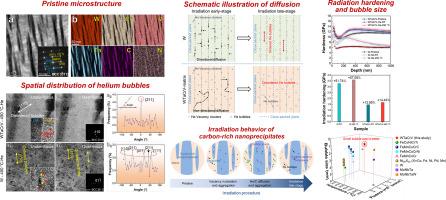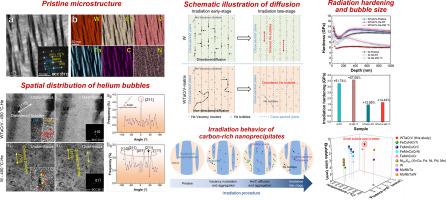Excellent radiation resistance via enforced local non-directional He diffusion in a WTaCrV multicomponent alloy containing coherent ordered nanoprecipitates
IF 8.3
1区 材料科学
Q1 MATERIALS SCIENCE, MULTIDISCIPLINARY
引用次数: 0
Abstract
We design and investigate a W15Ta15Cr35V35 (at.%) multicomponent alloy (MCA) with exceptional radiation resistance. The sintered WTaCrV alloy exhibits a body-centered cubic (BCC) matrix with dispersed coherent ordered nanoprecipitates. After ∼3-hour irradiation under 400 keV He+ at room temperature (RT) and 450 °C with a fluence of 2 × 1017 ions/cm2, the irradiation hardening values of the MCA are about a quarter of those of pure tungsten counterparts irradiated at identical conditions. Besides, helium bubbles generated in the irradiated matrix of the MCA are much smaller, compared with those in the pure tungsten and other tungsten-rich alloys previously reported. The exceptional radiation resistance of the present WTaCrV alloy can be mainly attributed to two synergistic mechanisms. First, the high lattice distortion of the solid solution matrix promotes the local non-directional diffusion of irradiation defects, effectively suppressing the aggregation of irradiation defects and helium atoms along specific orientations. This facilitates more uniform nucleation of helium bubbles in the alloy matrix. Second, carbon was introduced during fast hot pressing sintering as interstitial solute to form carbon-rich coherent ordered nanoprecipitates. The carbon-vacancy complexes generated in the nanoprecipitates inhibit the nucleation and aggregation of helium atoms at the vacancies during He+ irradiation. The above two mechanisms synergistically enhance the resistance against He+ irradiation. This work thus demonstrates a design strategy for high radiation resistance alloys by introducing well-tuned ordered coherent nanoprecipitates in multicomponent alloy systems.


在含有相干有序纳米沉淀物的 WTaCrV 多组分合金中,通过强化局部非定向 He 扩散实现优异的抗辐射性能
我们设计并研究了一种具有优异抗辐射性能的 W15Ta15Cr35V35 (at.%)多组分合金 (MCA)。烧结后的 WTaCrV 合金呈现出体心立方(BCC)基体和分散的相干有序纳米沉淀物。在室温(RT)和 450°C 条件下,以 2 × 1017 离子/cm2 的通量在 400 keV He+ 下辐照 ∼ 3 小时后,MCA 的辐照硬化值约为在相同条件下辐照纯钨的四分之一。此外,与之前报道的纯钨和其他富钨合金相比,MCA 辐照基体中产生的氦气泡要小得多。本 WTaCrV 合金之所以具有优异的抗辐射性能,主要归因于两个协同机制。首先,固溶体基体的高晶格畸变促进了辐照缺陷的局部非定向扩散,有效抑制了辐照缺陷和氦原子沿特定方向的聚集。这有利于氦气泡在合金基体中更均匀地成核。其次,在快速热压烧结过程中引入碳作为间隙溶质,形成富碳相干有序纳米沉淀物。纳米沉淀物中产生的碳-空位复合物可抑制 He+ 辐照时氦原子在空位处的成核和聚集。上述两种机制协同增强了抗 He+ 辐照的能力。因此,这项工作展示了一种通过在多组分合金体系中引入良好调谐的有序相干纳米沉淀物来设计高抗辐照合金的策略。
本文章由计算机程序翻译,如有差异,请以英文原文为准。
求助全文
约1分钟内获得全文
求助全文
来源期刊

Acta Materialia
工程技术-材料科学:综合
CiteScore
16.10
自引率
8.50%
发文量
801
审稿时长
53 days
期刊介绍:
Acta Materialia serves as a platform for publishing full-length, original papers and commissioned overviews that contribute to a profound understanding of the correlation between the processing, structure, and properties of inorganic materials. The journal seeks papers with high impact potential or those that significantly propel the field forward. The scope includes the atomic and molecular arrangements, chemical and electronic structures, and microstructure of materials, focusing on their mechanical or functional behavior across all length scales, including nanostructures.
 求助内容:
求助内容: 应助结果提醒方式:
应助结果提醒方式:


